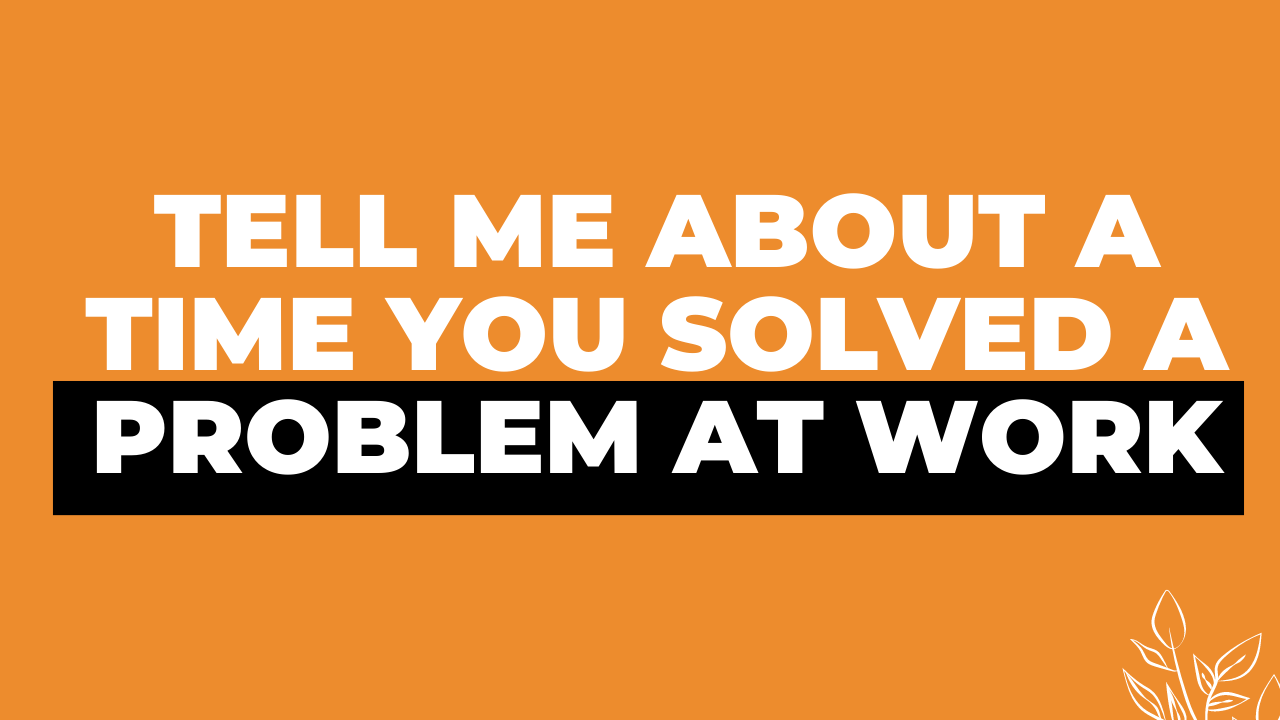“Tell me about a time you solved a problem at work” is a common behavioral interview question that employers ask to assess a candidate’s problem-solving skills, critical thinking abilities, and ability to work under pressure. This question requires the candidate to provide a specific example from their past work experience, rather than just general statements about their skills and abilities. It allows the employer to evaluate how the candidate approached a challenge, what actions they took, and what the outcome was. A well-crafted response to this question can demonstrate the candidate’s skills and experience, and provide insight into how they might approach similar challenges in the future.
Example 1
An employee might describe a time when they had to solve a problem in their previous role. For example, they might talk about a time when a project was falling behind schedule due to a team member’s absence, and they stepped up to take on additional responsibilities and help the team meet the deadline.
They might explain how they communicated effectively with the team and delegated tasks, and how they stayed organized and focused on the goal despite the added workload. They might also describe how they learned from the experience and implemented changes to prevent similar problems from occurring in the future.
The employee might conclude by emphasizing the importance of problem-solving skills and adaptability in the workplace, and how they were able to apply those skills to overcome the challenge.
Example 2
The employee might describe a time when there was a miscommunication with a client that led to a mistake in an order. The employee might explain how they took ownership of the problem and worked with their team to quickly address the issue and correct the mistake. They might describe how they communicated effectively with the client to apologize for the mistake and explain the corrective actions taken. They might also describe how they analyzed the situation to identify the root cause of the miscommunication, and implemented changes to prevent similar issues from happening in the future. The employee might conclude by emphasizing the importance of effective communication, problem-solving, and accountability in the workplace, and how they were able to apply those skills to resolve the issue and maintain positive relationships with clients.
Example 3
The employee might describe a time when a project they were working on encountered an unexpected setback. For example, they might talk about how a key vendor was unable to deliver a critical component on time, which threatened to delay the entire project.
They might explain how they worked with their team to quickly identify alternative vendors and negotiate a new timeline that minimized the delay. They might describe how they communicated the situation to the project stakeholders, including the client, and provided regular updates on the progress and revised timeline.
They might also describe how they reflected on the experience and identified opportunities for process improvement, such as building in more contingency plans for unforeseen events. The employee might conclude by emphasizing the importance of adaptability, creativity, and collaboration in the workplace, and how they were able to apply those skills to overcome the setback and deliver the project successfully.
Example 4
The employee might describe a time when there was a conflict between team members that threatened to derail a project. They might explain how they recognized the conflict and took steps to address it, such as scheduling a meeting to listen to each team member’s concerns and working with them to find a mutually acceptable solution.
They might describe how they facilitated open communication and encouraged team members to focus on the project’s goals rather than their personal differences. They might also describe how they followed up with the team to ensure that the conflict was resolved and that team members were working effectively together. The employee might conclude by emphasizing the importance of emotional intelligence, communication skills, and conflict resolution in the workplace, and how they were able to apply those skills to maintain team harmony and complete the project successfully.
Example 5
The employee might describe a time when they identified a process or system that was inefficient or ineffective, and they took steps to improve it. For example, they might talk about how they noticed that a certain process was causing delays or errors, and they conducted research to identify best practices and potential solutions.
They might explain how they developed a plan to implement the new process or system, and how they worked with their team to communicate the changes and train them on the new process. They might also describe how they monitored the results of the changes and made adjustments as needed to ensure that the process was running smoothly. The employee might conclude by emphasizing the importance of continuous improvement, problem-solving skills, and collaboration in the workplace, and how they were able to apply those skills to improve the efficiency and effectiveness of the process.
Example 6
The employee might describe a time when they encountered a difficult customer or client and were able to successfully resolve the situation. For example, they might talk about how a customer was unhappy with the product or service they received and how they listened to the customer’s concerns with empathy and understanding.
They might explain how they worked with the customer to identify a solution that met their needs, whether that was a refund, a replacement, or another type of resolution. They might also describe how they followed up with the customer to ensure their satisfaction and prevent similar issues from arising in the future.
The employee might conclude by emphasizing the importance of customer service skills, problem-solving, and conflict resolution in the workplace, and how they were able to apply those skills to maintain positive relationships with customers and improve the overall customer experience.
